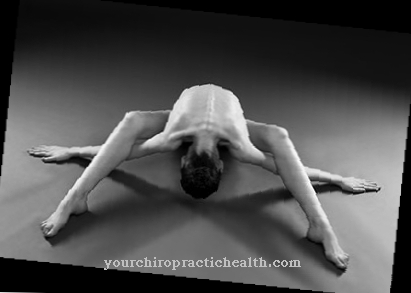Under Horner syndrome a specific nerve damage is understood that affects different eye muscles. The disease consists of a three-part symptom complex (a so-called symptom triad): This symptom triad includes a drooping upper eyelid, a clear constriction of the pupil and a sunken eyeball in the eye socket.
What is Horner Syndrome?

© blueringmedia - stock.adobe.com
The above-described three-part division into pupillary constriction, drooping eyelid and sunken eye is characteristic of the Horner syndrome.
In addition to these directly visible symptoms, there may be impaired sweat production in the various regions of the upper half of the body. Horner's syndrome is not viewed as an independent disease, but as a partial symptom of many other diseases.
Even so, some evidence suggests that various nerve damage is responsible for causing the symptom. The damaged nerves can be found anywhere in the body and can be triggered by various diseases. Familial and genetic causes are no longer excluded.
causes
The hypothalamus (an important area in the human brain) is responsible for controlling the muscles that are responsible for the Horner syndrome typical symptoms. In order to get from the hypothalamus to the eye and vice versa, the nerve pathways have to cover a complicated circuit via the spinal cord.
During this journey, the cranial nerves can be damaged at any time. Often there is damage to the nerve tracts due to circulatory disorders (this is mostly localized in the brain stem) or a brain tumor that affects the nerves concerned and can damage them. Cancer sores on the upper tip of the lung and pathological cavities in the cervical marrow can also damage nerves and trigger Horner's syndrome.
In addition, inflammation, localized in the middle cranial fossa, can also lead to the triad of symptoms of Horner's syndrome.
Symptoms, ailments & signs
In most cases, Horner's syndrome manifests itself as symptoms in the eye area on one side of the body, but not on both sides. The disease makes itself felt in the area of the pupil, the eye socket and the eyelid.
The function of the pupil is disturbed in Horner's syndrome. Regardless of the brightness, the pupil is always narrowed. Therefore, patients complain that their eyesight is impaired in the dark because ambient light does not reach the retina sufficiently.
Due to the failure of the orbital muscle, the eyeball has sunk slightly into the skull. In healthy people, the muscle ensures that the eye protrudes a little. Depending on the severity of the disease, this retraction of the eyeball will be more or less visible.
Many patients with Horner's syndrome complain of drooping eyelids. This symptom is due to a dysfunction of the Müllerian muscle. In addition to these three classic symptoms, there are other symptoms.
They also only occur on one half of the face. Different colors of the iris, pigment disorders or dilated vessels are indications of Horner's syndrome. In some cases, patients no longer sweat properly on one half of their face. One speaks then of a disturbance of the sweat secretion.
Diagnosis & course
The tripartite symptom complex is easy to recognize. In patients with Horner syndrome if the damaged pupil is relatively smaller than the intact pupil, the eyelid hangs down and can only be lifted minimally even with exertion.
In response to light, the pupil dilates slowly and usually incompletely in Horner's syndrome. The other symptoms are also clearly visible, because z. For example, the increased sweat secretion can be clearly observed on the skin in some body regions, while some regions show no sweat production whatsoever.
By administering cocaine and amphetamine eye drops, the damage can be localized and its extent determined. The physical impairment only affects the eye and eye muscles. For example, due to the pupil constriction, the perception behavior of the eye can change in a negative sense, the field of vision is reduced by the drooping eyelid and three-dimensional vision can be significantly impaired.
Most of the time, patients with Horner's syndrome suffer particularly from psychological stress, as the facial expressions and expression of the face can change significantly as a result of the symptoms.
In the further course, it must be concluded for what reason the symptoms of Horner's syndrome occur and which other disease is responsible. This is the only way to effectively treat the symptoms.
Complications
The Horner syndrome causes considerable discomfort to the eyes, which can have an extreme effect on the life of the person affected. In most cases, the pupils are greatly enlarged and the eyeball is retracted. Furthermore, the upper eyelids can droop and thus negatively affect the patient's aesthetics. The cosmetic complaints often lead to inferiority complexes or a reduced self-esteem.
It is not uncommon for patients to feel ashamed of the symptoms. In severe cases, it can also cause a visual disturbance or other impairment of vision. These usually have a negative effect on the everyday life of the person affected and also reduce the quality of life. In most cases there is no direct treatment for Horner's syndrome and its symptoms.
Instead, the underlying disease is always examined and treated, without any particular complications. The symptoms mostly disappear when the underlying disease has also been defeated. Life expectancy is not changed or reduced by Horner syndrome. In most cases, the disease does not go away on its own, so the symptoms increase without treatment.
When should you go to the doctor?
If Horner syndrome is suspected, a doctor must be consulted promptly. Typical warning signs that need to be clarified are constricted pupils and a sunken eyeball, often associated with visual disturbances, pain in the eye area and excessive sweating. If these symptoms occur, it is most likely a serious medical condition that needs investigation and treatment, if necessary. It is not always Horner's syndrome, but medical advice is always necessary.
This is especially true if the symptoms appear to appear for no reason and persist over a longer period of time. People who have had a brain tumor in the past are particularly prone to developing Horner's syndrome. Nerve disorders and syringomyelia are also possible causes of the syndrome. Anyone who belongs to these risk groups is best to speak to the responsible doctor. In addition to the family doctor, an ophthalmologist or neurologist can also be involved. Emergency medical treatment is required in the event of a medical emergency.
Doctors & therapists in your area
Treatment & Therapy
To treat the Horner syndrome no special therapy is developed. This is mainly because there are many different causes that can lead to Horner's syndrome.
Treating the actual disease - which is the cause of Horner's syndrome - also alleviates the three-part symptoms.
The treatment is therefore always individually tailored to the actual ailments of the patient and goes hand in hand with the treatment of the causative disease. If the treatment leads to an improvement in the state of health, then in most cases there is also an improvement in Horner's syndrome.
If the symptoms of Horner's syndrome are not relieved, other causes for these symptoms can be identified.
You can find your medication here
➔ Medicines for eye infectionsOutlook & forecast
So far, there is no treatment method that can specifically and completely cure Horner's syndrome. Patients and doctors must therefore broaden their perspective and search for the cause. The reasons for Horner's syndrome can often be eliminated. If this succeeds, the three typical symptoms miosis, ptosis and enophthalmos usually subside. Basically, the probability of a positive outcome increases if a disease is treated early. If there is no therapy, the symptoms increase. Horner syndrome itself does not affect life expectancy.
Sometimes the nerve is severed by the underlying disease. Those affected then have to deal with Horner's syndrome for the rest of their lives. A cure is impossible. This prospect plunges many patients into deep inner conflict. As the facial expressions change, they often suffer from reduced self-confidence. The aesthetic effects, which among other things cause the drooping eyelid, can hardly be concealed. In this situation, there is a risk that a long-term psychosis will develop. The quality of life suffers. Starting from this situation back into everyday life is impossible for many without outside help.
prevention
For the prophylaxis of Horner syndrome the patient can hardly contribute. Horner's syndrome develops due to another disease, the development of which patients usually have no control over. Ultimately, a tumor cannot be foreseen and ultimately avoided, just like a circulatory disorder or a motorcycle accident with damage to the arm nerve plexus, which can also lead to the symptoms of Horner's syndrome.
Aftercare
In Horner's syndrome, the options and measures for follow-up care are very limited in most cases. Since this is also a congenital disease, this disease cannot be treated causally, but only symptomatically. If you want to have children, genetic counseling can also be carried out to prevent the disease from being passed on.
In the case of Horner's syndrome, the focus is therefore above all on the early detection of the disease so that the symptoms do not worsen further. The treatment of Horner's syndrome depends primarily on the exact underlying disease. It is not always possible to achieve an improvement.
If the illness leads to psychological upsets or depression, loving care for your own family and friends has a very positive effect on these complaints. Regular checks by a doctor are also very important. If the syndrome is treated by taking medication, ensure that it is taken correctly and regularly. Possible interactions with other drugs must also be taken into account. In the case of children, parents should especially ensure that they are taken correctly.
You can do that yourself
The patient cannot contribute to the treatment of Horner's syndrome himself. In any case, the affected person is dependent on medical treatment in order to limit the symptoms of the syndrome. Preventing the syndrome is usually not possible either.
In many cases, patients need support and psychological treatment. This can come from your own friends and family, but should also be accompanied by visits to the psychologist. Children must be informed about the disease and its possible consequences in order to ensure the child's psychological stability. Conversations with other sick people can also help. Due to the visual problems, the patients are dependent on the help of other people in their everyday life. Warm and warm care has a very positive effect on the course of Horner's syndrome.
Due to the disturbed sweat production, patients should wear airy and light clothing, especially in summer, in order to avoid sweating and thus unpleasant situations. The disturbances of the blood circulation can in some cases be limited by massages or heat applications. However, a complete cure of Horner's syndrome is not possible.


.jpg)










.jpg)

.jpg)
.jpg)











.jpg)